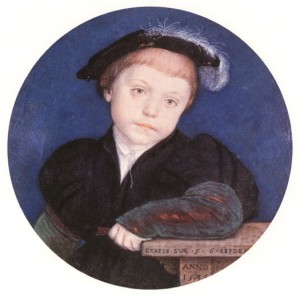In 1528, Du Bellay, the French ambassador wondered if Henry VIII and Anne Boleyn’s relationship was strong enough to survive an extended period of separation. The ambassador’s question was soon answered, when on 16 June 1528, one of Anne’s ladies in waiting fell ill with the dreaded sweating sickness, ‘a highly contagious and frequently fatal disease’ that Eric Ives believes was probably a virus infection similar to the Spanish flu of 1918 (Pg. 100).
As usual, when there was any sign of disease, Henry VIII fled from house to house seeking refuge from the killer epidemic. Anne Boleyn returned to the family home at Hever and the King, accompanied by Queen Katherine, ‘began a most meticulous round of religious observances’ (Ives, Pg. 100).
Yet this did not stop Henry from writing to his beloved Anne and on hearing of her sudden illness the king wrote that he ‘would gladly bear half of your illness to make you well’ (Love Letters to Anne Boleyn, Pg. 22).
He also wrote to her to reassure her that ‘few women or none have this malady’ but despite the King’s words of encouragement, Anne Boleyn fell ill with the disease whilst at Hever Castle. Her father, Thomas Boleyn too came down with the sweat during this epidemic (Starkey, Pg. 331).
On the 22 June, the very same day that Anne Boleyn took to her bed, William Carey, Mary Boleyn’s husband, succumbed to the disease (Weir, Pg. 186).
The King responded by sending his second-best doctor, William Butts, ‘the physician in whom I put most trust is now at this time absent when he could most do me pleasure’ (Ives, Pg. 101).
Butts carried a letter of ‘sympathy and support’ from Henry and signed with the initials ‘H’ and ‘R’ flanking a heart and ‘AB’ (Ives, Pg. 101). Henry urged Anne to ‘to be guided by his (Dr. Butts’) advice in your illness’ so that they might be together again soon, which to the king would be ‘greater comfort than all the precious jewels in the world’ (Love Letters to Anne Boleyn, Pg. 23).
Luckily for Butts, both Anne and her father recovered.
And Butts’ endeavours did not go unrewarded. By Christmas 1528, he had been appointed Royal Physician and enjoyed a very healthy salary of 100 pounds per year (Starkey, Pg. 332).
He also went on to forge a close relationship with Anne, looking after both her physical health and spiritual welfare (Starkey, Pg. 332).
Cardinal Wolsey advised the king and council on what precautions to take while the sweating sickness ran its course. Brian Tuke, a counselor, reported that the king,
“thanked your grace: and showing me, first, a great process of the manner of that infection; how folks were taken; how little danger was in it, if good order be observed; how few were dead of it; how Mistress Anne, and my lord of Rochford, both have had it; what jeopardy they have been in, by returning in of the sweat before the time; of the endeavour of Mr. Butts, who hath been with them, and is returned; with many other things touching those matters, and, finally, of their perfect recovery.” (Ives, Pg. 101)
The King was so overjoyed by Anne’s full recovery that he sent her letters and gifts, as did Cardinal Wolsey.
Within about a month, after an imposed period of quarantine, Anne Boleyn was back at court and Du Bellay had a clear answer to his earlier question. The separation had no negative effect on Anne and Henry’s relationship. On the contrary, on Anne’s return, Du Bellay noted ‘the king is in so deeply that God alone can get him out of it’ (Ives, Pg. 101).
The time Henry and Anne had spent apart had not abated Henry’s passion for Anne; instead it had fuelled the fire within his heart.
It seems that in this case, absence did make the heart grow fonder.
I think it’s important now to look in a little more detail at the ‘sweating sickness’ in order to understand just how lucky Anne and her father were to survive it. Especially when considering that it claimed the lives of most that contracted it, including both of Charles Brandon and Catherine Willoughby’s sons, Henry and Charles, within hours of each other in 1551.
When did the Tudor sweating sickness appear?
The sweating sickness, one of the most feared and deadly diseases of the Tudor period, first reared its ugly head in 1485. It struck with great ferocity leaving many dead.
From 1485 until 1507, when a less widespread outbreak occurred, the disease, in England, lay virtually dormant.
In 1517 it resurfaced again, this time resulting in a more deadly epidemic. In Oxford and Cambridge the disease was frequently fatal and in some towns, claimed half of the cities population.
In 1528 the sweating sickness returned with full force, breaking out in London and quickly spreading over the whole of England. The high mortality rate in London forced the court to break up, abandon the summer progress and flee in search of safety.
On this occasion, the epidemic crossed the English Channel and spread through Europe with many succumbing to the disease within a few weeks.
There were reported cases in Switzerland, Denmark, Sweden and Norway also emerging in Antwerp and Amsterdam.
By the end of the year, the epidemic had all but disappeared never to return again to mainland Europe.
England though was not so lucky and in 1551, the last major reported outbreak of the disease took place.
What were the symptoms of the sweating sickness?
The symptoms started very suddenly and were typical of a viral infection or the flu: a sense of apprehension, headaches, cold shivers, muscle aches and great exhaustion.
This was followed by a hot and sweating stage that was accompanied by headaches and delirium. The patient would also suffer chest pains and encounter difficulty breathing.
Death usually occurred within 24 hours of the first symptom although in some cases the patient died within a few hours of contracting the disease.
What was the cause of this frightening disease?
Some suggest that the sweating sickness was brought over from France with Henry VII armies in 1485.
Unfortunately, the exact origin and cause is unknown although many historians concur that it was probably related to the modern disease known as Hantavirus. The problem with this theory is that Hantavirus Pulmonary Syndrome is a ‘deadly disease transmitted by infected rodents through urine, droppings, or saliva’ and the sweating sickness was thought to have been transmitted from human to human.
Also, the disease for the most part targeted healthy men of status although women were not immune. One would imagine that the poorer Tudors would have come into contact more frequently with rodents and rodent droppings than the wealthy Tudors. Standards of hygiene were not the greatest in Tudor England regardless of your status but Henry VIII was terrified of disease and maintained a better standard of hygiene than what he is generally given credit for.
Another proposed theory is Relapsing Fever transmitted through the bites of lice or ticks although again this doesn’t explain why the sweating sickness was more prevalent in wealthy societies.
In addition, this infection leaves a black scab at the site of the bite and those nursing those afflicted with the Tudor disease made no such reports.
So it seems that the sweating sickness is another Tudor mystery that will continue to intrigue and perplex us for many years to come.
References & Sources
Ives, E. The Life and Death of Anne Boleyn, 2004.
Love Letters of Henry VIII to Anne Boleyn, n.d.
Starkey, D. Six Wives: The Queens of Henry VIII, 2003.
Weir, A. The Six Wives of Henry VIII, 2007.




















Interesting article–I was especially glad to get the symptoms straight. I read or saw somewhere that is might have been a sort of malaria because it kept coming back every so often. Who knows? Thanks so much!
Thanks Anne! Another fascinating Tudor mystery for us to ponder!
Great article! I’ve always wished that this mystery would eventually be answered…. So many questions about this most fascinating time period…
Thank you Marie! There are so many questions and that’s why we love Tudor history so much! 🙂
Thank you for the great article. Having watched the Tudor Episode 1:7 again which combines the outbreak of 1517 and the outbreak of 1528 to cause more confusion; and it is extraordinary that this disease swept through parts or Europe and England and Scotland and then vanished. It arrived with the soldiers from France come to support Henry VII in 1485, comes back 1502, 1507 and 1517 sweeps through most of Oxfordshire and Cambridgeshire, each time it is more violent and virile than before. It comes back in 1528 and attacks most of the court as well as London and the south, taking Sir William Compton and William Carey amongst others to their deaths. Anne Boleyn, the most famous one to get it and survive, and then it also comes back in 1551, killing Charles Brandon’s two young sons, Henry and Charles within hours of each other. It is last recalled in 1578 and vanished.
It is now identified by doctors, but it is not really certain what caused it as most historians are not medical and what seems remarkable to me it that compared to the hundreds of books and studies done on the plague and black death; hardly anything exists that really looks at the sweat and the attacks in England and Europe either from a medical point of view or as a history. It would be so interesting to look at this disease in far more detail and to read something more complex and professional about it.
As a foot-note, it may have appeared a few years ago in north America with nine cases being reported.
The plague and the black death are they the same thing, both contracted from rat flee bites?
If the ‘sweat’ mainly hit the men and women of status, rather than the poor, I wonder if it could be that as the poor had a better immune system because of the awful conditions they lived in, as we know hygene was not as we see it now-a-days, but it would have been better than the poor. Also I wonder if because that men of status were more likely to go into the towns and cities than their ladies, therefore contacted it more, and if it struck you down that quick the men would maybe never get home to pass it on, in some cases anyway…just a thought.
For Anne and her father to survive it is amazing, they must have had stronger constitutons than most, or fate perhaps!!
I wonder if the sweat really hit the wealthy harder, or if the poor were unrecorded & unnoticed at the time?
So sad that many people were killed by what we today pretty much know as, as flu! There were many deaths and people who fell ill during the Planatagenet’s reign with this illness also. Seems to date back rather far.
Think about this , wealthy had a different diet that peasants had ie ….quail eggs
Eels and such, I feel the sickness was due to the diet of the wealthy
true servants caught it but, did they not sneak the food the rich were eating too ? It’s something in the food chain of the aristocrats .
I’m think ..avian flu strain
This was a great explanation of the sweating sickness. I am watching the tudors right now, and this was helpful.